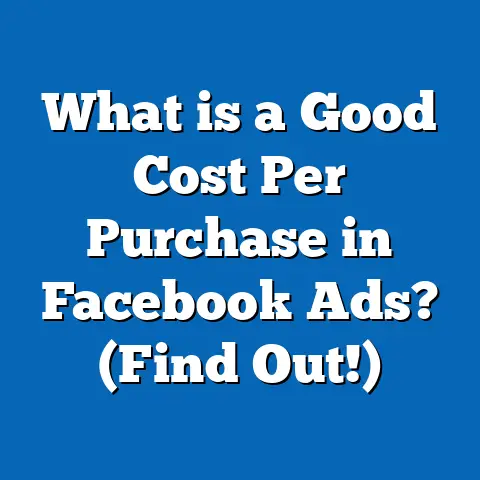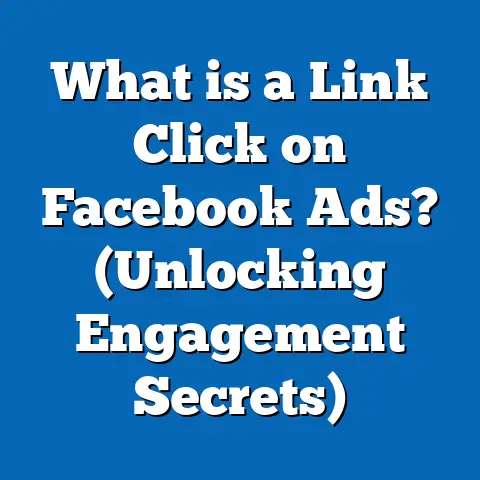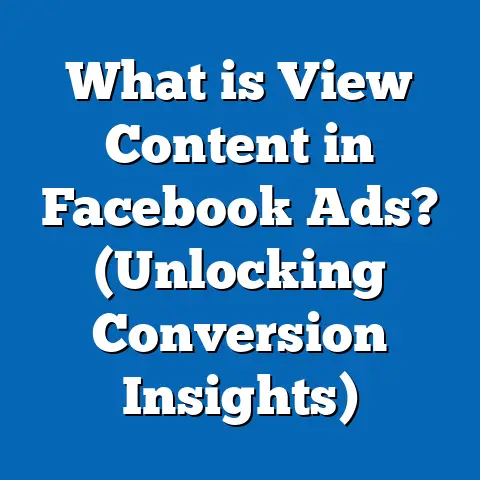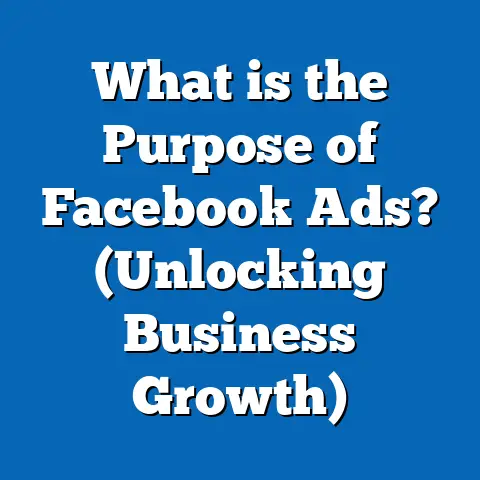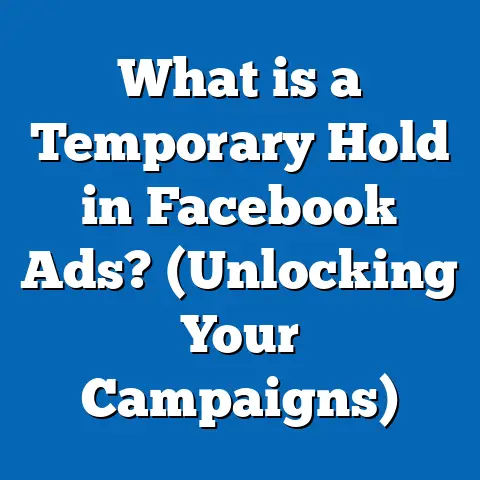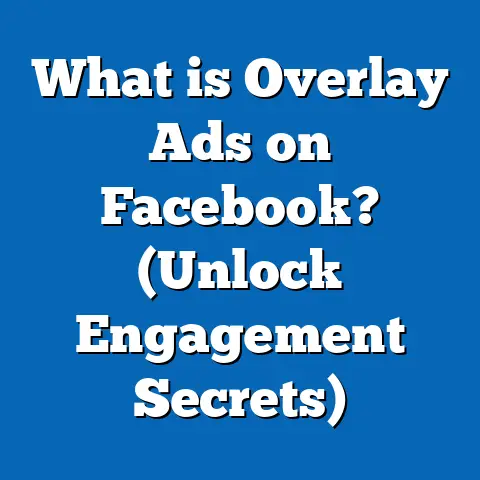What is a Facebook Video Ad? (Unlocking Engagement Secrets)
Introduction: Noise Reduction in the Age of Digital Advertising
In the digital era, consumers are overwhelmed with an average of over 5,000 marketing messages every single day. This flood of information creates what marketers call “advertising noise.” It’s the clutter of competing messages that dilutes the impact of any one advertisement. Amid this chaos, brands face a significant challenge: how can they break through the noise to capture and hold their audience’s attention?
The answer lies in a strategic use of engaging formats that stand out visually and emotionally. Facebook video ads have emerged as a powerful tool to reduce noise by creating immersive experiences that demand attention. Unlike static images or plain text ads, video ads combine motion, sound, and storytelling to engage multiple senses simultaneously. This multi-sensory approach not only grabs attention but also improves message retention and conversion rates.
With Facebook’s robust advertising platform offering precise targeting and diverse ad formats, marketers can tailor video ads to specific audience segments with greater accuracy than ever before. This reduces wasted impressions and increases the likelihood that the right people see the right message at the right time.
What Is a Facebook Video Ad?
Facebook video ads are short or long form promotional videos delivered through Facebook’s diverse ad placements. Unlike traditional advertising that relies on static images or text, video ads integrate movement and sound to tell compelling brand stories or showcase products in action.
The Evolution of Facebook Video Ads
Facebook began supporting video ads in its news feed around 2014 as online video consumption surged globally. Since then, it has continuously enhanced video ad formats, targeting capabilities, and analytics tools to meet evolving advertiser needs. Today, Facebook’s ecosystem includes Facebook itself, Instagram (owned by Facebook), Messenger, and Audience Network—all accessible for video ad placements via Facebook’s Ads Manager.
Features Defining Facebook Video Ads
- Multi-Platform Reach: Video ads can appear on Facebook’s desktop and mobile apps, Instagram feed and stories, Messenger inbox, and across partner apps in the Audience Network.
- Diverse Video Formats: Including in-feed videos, stories ads, carousel videos (multiple videos users swipe through), slideshow ads (video created from images), collection ads combining video with product catalogs, and in-stream ads (short videos inserted into longer content).
- Advanced Targeting: Allows marketers to define audiences by demographics (age, gender), interests (hobbies, pages liked), behaviors (purchase habits), location, device type, and more.
- Interactive Elements: Call-to-action buttons (Shop Now, Learn More), links to websites or app download pages.
- Performance Metrics: Facebook provides detailed insights like video views (3-second and 10-second), average watch time, engagement rates (likes, shares), click-through rates (CTR), and conversion tracking.
Why Facebook Video Ads Matter: Data-Backed Insights
Advertising effectiveness hinges on capturing attention and driving action. Over the past decade, video has transformed from a niche format into the dominant force in online content consumption and engagement.
Key Statistics Demonstrating Video’s Impact on Facebook
- Organic Reach Advantage: According to Facebook’s internal data, video posts generate 135% more organic reach than photo posts on average. This means videos naturally appear more frequently in users’ feeds without paid boosting.
- Consumer Preference: HubSpot’s 2023 consumer survey revealed that 54% of people want to see more video content from brands they follow.
- Internet Traffic Surge: Cisco’s Visual Networking Index forecasts that by 2024 video will account for 82% of all internet traffic globally.
- Daily Consumption: Facebook users collectively watch over 100 million hours of video daily on the platform—a staggering figure that illustrates massive user appetite for video content.
- Higher Engagement Rates: Video ads see an average engagement rate of 6.13%, significantly higher than static image ads at 3.16%, per a recent WordStream benchmark report.
- Conversion Power: A study by Animoto found that 73% of consumers are more likely to purchase after watching a product video.
These numbers demonstrate why marketers should prioritize video when designing their campaigns on Facebook.
The Science Behind Engagement: Why Video Works
Understanding why video ads outperform other formats begins with cognitive psychology and human attention science.
Multi-Sensory Stimulation Drives Memory
Video ads engage both visual and auditory senses simultaneously. This dual stimulation activates multiple brain regions responsible for processing information. The brain processes images 60,000 times faster than text—moving pictures combined with sound create a stronger emotional impact and improve recall.
Emotional Connection Through Storytelling
Stories are fundamental to human communication. Video enables brands to tell stories visually with characters, music, tone of voice, and narrative arcs that evoke emotions such as joy, excitement, empathy, or curiosity. Emotional responses increase trust and brand affinity.
Attention Span Dynamics
Research from Facebook IQ shows that:
- The first 3 seconds are critical — viewers decide quickly whether to keep watching or scroll away.
- Videos under 15 seconds have a completion rate of up to 70%.
- Beyond 30 seconds, viewer drop-off increases rapidly unless the content is highly engaging or valuable.
Marketers need to craft concise messages that deliver key information upfront while maintaining viewer interest throughout.
Cognitive Load Theory
Complex messages delivered in short bursts improve comprehension and retention. Facebook video ads should avoid overwhelming viewers with too much information at once.
Types of Facebook Video Ads and Their Uses
Facebook offers multiple video ad formats suited for different campaign goals and audience behaviors.
1. In-Feed Video Ads
Description: Appear natively within users’ news feeds alongside organic posts.
Best For: Brand awareness campaigns seeking broad reach; storytelling; demonstrating product benefits.
Example: A travel agency showing a vibrant montage of vacation destinations with a CTA to “Book Now.”
2. Stories Video Ads
Description: Full-screen vertical videos that appear between users’ stories.
Best For: Short-lived promotions; immersive experiences; reaching younger audiences.
Example: A fashion brand showcasing limited-time sales with swipe-up links for instant shopping.
3. Carousel Video Ads
Description: Multiple videos or images users can swipe horizontally through within one ad unit.
Best For: Highlighting product features or a range of products; telling sequential stories.
Example: An electronics retailer presenting different smartphone models with specs on each carousel card.
4. Collection Ads with Video
Description: Combines an introductory video with a product catalog displayed below it.
Best For: E-commerce brands aiming to drive direct purchases without leaving Facebook.
Example: A furniture store showing a lifestyle video followed by clickable product tiles for easy shopping.
5. In-Stream Video Ads
Description: Short ads placed within longer Facebook videos or live streams.
Best For: Reaching engaged viewers during content consumption; retargeting warm audiences.
Example: A fitness brand inserting quick workout tips ads into related health videos.
Advanced Targeting and Optimization Strategies
Facebook’s strength lies in its ability to target very specific audience groups. Marketers can optimize their video ad campaigns by combining various targeting options:
Custom Audiences
Allows advertisers to upload existing customer lists (email addresses or phone numbers) or retarget website visitors via Facebook Pixel tracking. This ensures ads reach people who already know your brand or have shown interest.
Lookalike Audiences
Facebook analyzes your best customers’ profiles to find similar users who are likely to be interested in your products or services. This method helps expand reach efficiently while maintaining relevance.
Behavioral Targeting
Target people based on online behavior such as recent purchases, device usage patterns (iOS vs Android), travel frequency, or engagement with specific types of content.
Interest-Based Targeting
Choose audiences based on interests like sports fans, cooking enthusiasts, or tech geeks derived from their Facebook activity and page likes.
Engagement Retargeting
Retarget users who watched your previous videos but didn’t convert by showing follow-up ads with stronger offers or new creative approaches.
Case Study: Boosting Engagement with Facebook Video Ads
Company Overview
A mid-sized online fashion retailer specializing in casual wear wanted to increase sales during their spring collection launch. Their previous static image campaigns generated moderate traffic but low engagement rates.
Campaign Objectives
- Increase brand awareness for new collection.
- Drive traffic to product pages.
- Boost online sales conversion rates during promotion period.
Strategy
- Developed a series of in-feed video ads featuring models showcasing multiple outfit styles in urban settings.
- Each video was 20 seconds long emphasizing key product features (comfort fabric, trendy cuts).
- Used custom audiences targeting previous website visitors plus lookalike audiences for new prospects.
- Employed A/B testing on CTAs: “Shop Now” vs “See Collection.”
- Added captions for silent viewing.
Results After One Month
| Metric | Before Campaign | After Campaign | % Change |
|---|---|---|---|
| Engagement Rate | 2.1% | 3.0% | +42% |
| Click-Through Rate (CTR) | 0.9% | 1.8% | +100% |
| Conversion Rate | 1.2% | 1.5% | +25% |
| Return on Ad Spend (ROAS) | 3:1 | 4:1 | +33% |
The campaign significantly improved user engagement and sales performance compared to previous static image ads.
| Platform | Strengths | Weaknesses | Ideal Use Cases |
|---|---|---|---|
| Massive user base; advanced targeting; multiple ad formats; integration with Instagram & Messenger | High competition; potential ad fatigue | Broad reach; retargeting; direct response | |
| Visual-first; strong appeal among younger demographics; Stories & Reels formats | Limited link options for non-business accounts | Lifestyle branding; influencer marketing | |
| YouTube | Long-form content-friendly; high intent viewers searching for information | Higher production costs; longer lead times | Tutorials; product demos; educational content |
| TikTok | Viral potential; organic reach; short-form creative videos | Brand safety concerns; limited targeting options | Trend-based campaigns; youth marketing |
| Professional audience targeting; B2B focus | Higher CPCs; less effective for B2C | B2B marketing; recruiting; thought leadership |
Facebook strikes a balance between reach, precision targeting, and diverse creative options making it suitable for most marketers aiming to maximize ROI on video advertising.
Technical Considerations for Creating Effective Facebook Video Ads
Creating compelling Facebook video ads requires attention to both creative quality and technical specifications:
Video Resolution & Aspect Ratios
- Recommended minimum resolution is 720p for clarity.
- Supported aspect ratios include:
- 1:1 (Square): Versatile for feed placements.
- 4:5 (Vertical): Optimized for mobile feeds.
- 9:16 (Full vertical): Best for Stories and Reels.
- 16:9 (Landscape): Traditional widescreen format.
Choosing the correct aspect ratio based on placement maximizes screen real estate without black bars or cropping.
File Formats & Size Limits
- Accepted file types are MP4 or MOV.
- File size should ideally be under 4 GB for faster loading.
- Longer videos up to 240 minutes are supported but shorter clips (<30 seconds) perform better for ads.
Sound & Captions
Since many users watch videos without sound (up to 85% according to Facebook IQ), adding captions is essential. Captions also improve accessibility for hearing-impaired users and help convey messages clearly regardless of environment.
Thumbnail Selection
Choose attractive thumbnails that preview the video’s content effectively when autoplay is off or during loading delays.
Measuring Success: Key Metrics for Facebook Video Ads
To truly understand how your Facebook video ad performs, monitor these detailed metrics:
| Metric | What It Measures | Why It Matters |
|---|---|---|
| Video Views (3-sec & 10-sec) | Number of times users watched at least first 3 or 10 seconds | Indicates initial interest level |
| Average Watch Time | Average duration users watch the video | Shows how engaging the content is |
| ThruPlay | Number of times video played at least 15 seconds or full length if shorter | Measures meaningful reach |
| Engagement Rate | Likes, shares, comments relative to impressions | Reflects audience interaction |
| Click-Through Rate (CTR) | Percentage clicking CTA links post-view | Tracks effectiveness in driving action |
| Conversion Rate | Percentage completing desired actions (purchase/sign-up) | Measures ROI directly |
| Cost Per Result | Average spend per conversion or click | Helps optimize budget allocation |
Utilize Facebook Ads Manager reports alongside Google Analytics data for deeper insights into user behavior post-click.
Practical Tips for Maximizing Facebook Video Ad Impact
Here are actionable recommendations drawn from industry best practices:
- Start Strong With a Hook: Capture attention within the first three seconds using bold visuals or intriguing questions.
- Show Your Brand Early: Include logos or brand colors front-loaded so viewers associate content quickly.
- Keep It Concise: Prioritize key messages within 15–30 seconds while maintaining storytelling flow.
- Use Clear Calls-To-Action (CTAs): Guide viewers explicitly about next steps such as “Shop Now,” “Learn More,” or “Sign Up.”
- Optimize for Mobile Viewing: Design videos vertically or square since over 94% of Facebook usage is via mobile devices.
- Test Different Creatives & Audiences: Run A/B split tests on video length, style, copy variations, target segments to identify top performers.
- Leverage User Generated Content (UGC): Real customer testimonials or unpolished clips increase authenticity and trust.
- Incorporate Subtitles & Captions: Ensure your message is understood even without sound.
- Use Analytics to Refine Campaigns: Regularly review performance data and pause underperforming ads quickly.
- Retarget Engaged Viewers: Follow up with personalized offers or additional content toward warm leads identified via engagement metrics.
Emerging Trends in Facebook Video Advertising
The landscape of video advertising evolves rapidly as technology advances:
Interactive Videos
Facebook is experimenting with polls embedded inside videos allowing viewers to engage directly without leaving the platform. Early tests show increased engagement rates by up to 20%.
Augmented Reality (AR) Ads
AR effects integrated into Stories enable users to virtually try on products such as sunglasses or makeup before purchase—driving deeper interaction.
Shoppable Video Ads
These allow viewers to click on products featured in videos without leaving Facebook—streamlining e-commerce conversions significantly.
AI-Powered Personalization
Artificial intelligence algorithms now help tailor dynamic video content based on individual user data like browsing history or preferences in real-time—boosting relevance dramatically.
Deep Dive: How To Create a Winning Facebook Video Ad Campaign Step-by-Step
Step 1: Define Your Objectives Clearly
Determine what you want from your campaign—brand awareness? website traffic? conversions? Setting clear goals guides all subsequent decisions including creative development and budgeting.
Step 2: Know Your Audience Inside Out
Use Facebook Audience Insights tool to analyze demographics, interests, behaviors so you can build accurate personas for targeting.
Step 3: Craft Your Message & Storyboard Your Video
Plan compelling narratives aligned with buyer pain points or desires. Outline key scenes focusing on visual storytelling complemented by simple text overlays if needed.
Step 4: Produce Quality Videos Within Budget
Invest in professional-looking visuals but don’t overspend unnecessarily—sometimes authentic raw footage performs better than polished commercials depending on brand voice.
Step 5: Set Up Targeted Campaigns in Ads Manager
Choose placements suited for your format (Feed vs Stories). Use layered targeting combining custom/ lookalike audiences plus interest filters.
Step 6: Launch & Monitor Closely
Watch early metrics like view rates & CTRs closely during first few days—pause low performers promptly.
Step 7: Optimize Continuously Based on Data Insights
Iterate creative elements or audience segments monthly based on detailed analytics reports until you hit desired KPIs.
Summary and Next Steps
Facebook video ads reduce advertising noise by delivering immersive multi-sensory experiences customized precisely for target audiences. They outperform static formats because they engage emotions quickly while offering diverse creative options adaptable across devices and placements.
Final Takeaways:
- Prioritize concise storytelling within first few seconds.
- Use captions for silent viewing environments.
- Employ advanced targeting including retargeting & lookalikes.
- Test different ad formats & creatives regularly.
- Analyze metrics beyond views—focus on engagement & conversions.
- Stay updated with emerging trends like interactive & shoppable videos to stay competitive.
For marketing professionals and business owners ready to deepen their skills, investing time in mastering the nuances of Facebook video advertising will yield significant payoff in terms of engagement quality and return on investment.

